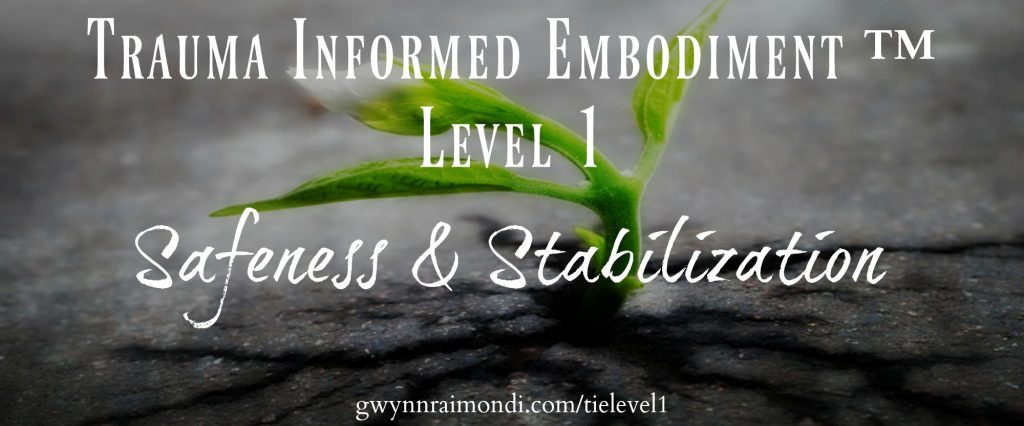
August 1, 2018 through January 31, 2019
Weekly emails with information, exercises, and homework
Six 90-minute live group calls (one per month)
PDF booklet of all materials (to be distributed at the end of our program)
Private Facebook group for us to continue our learning and connecting
$750 USD or $125/month for six months (other payment plan options also available)
Note: By registering for this program you agree to the Office Policy and Client Service Agreement terms and conditions.
Registration is now closed. The next cohort will begin February 1, 2019. To learn when this and other offerings are open for registration, subscribe to my weekly newsletter here.
Unprocessed trauma lives in all of us. Be it from the traumatic events of our own lived experience or that of our ancestors or the traumatic impact of living in our patriarchal culture.
Trauma impacts us emotionally, psychologically, and physically. It alters our DNA. It affects the ways we are able to interact in the world.
Some of the signs that we have trauma living in our bodies:
- Unexplained or “illogical” fear
- Anxiety
- Depression
- Hyper-vigilance (also related to fear and anxiety)
- Extreme irritability
- Emotional dysregulation (mood swings; cannot soothe self easily; once triggered into anger or sadness or fear cannot easily come out of it)
- Disassociated from the body (cannot feel your body or sense your physical boundaries; bumping into walls or furniture, not knowing where bruise or cuts/scrapes have come from)
- Disassociated from the present (stuck in past and or future thinking)
- Inability to concentrate and stay focused on one thing for an extended period of time
- Self-isolation (withdrawing from or not connecting to others)
- Feelings of shame and self-blame and claiming responsibility for things that are out of your control
Additionally the following physical health issues are also associated with trauma:
- autoimmune disorders
- gastrointestinal disorders
- reproductive system disorders
- fatigue
- thyroid and or adrenal dysfunction/endocrine system disorders
- insomnia and/or nightmares and/or night terrors
- racing heart beat and shortness of breath (panic attacks)
- muscle tension
- sexual dysfunction
- migraines
Our bodies and minds are interconnected. When we experience a traumatic event not only are our minds and brains impacted, our bodies, and all the systems within our body, are too. Studies have shown how trauma lives within our bodies, in not only our DNA but also in our muscular and cellular memory. Other studies have shown that in order to truly process trauma, we need to utilize both talk therapy and somatic therapies – in other words, we need to connect with another person and with our own body to truly process the trauma that lives within us.


Processing Trauma in Community
One of the effects of trauma is self-isolation. Those who live with trauma tend to withdraw from friends, family, and their greater community. They may be able to be out in the world, however, we do not allow ourselves to connect and or be present with our environment, including the people in it.
Being in community in and of itself helps us to break the patterns and cycles of trauma as well as creates space for us to begin to process it. Community can look like one other person or ten other people. Community can consist of family, friends, mental health and medical professionals, spiritual mentors, and even strangers-who-become-friends. Our own communities today are no longer defined by physical location as they had been in years past. This creates more opportunities for us to connect with others on similar journeys in this work of processing trauma.


About Gwynn
I am a licensed marriage and family therapist associate in the state of Washington in the US. My main focus in my work is trauma, grief, embodiment and their intersections. I deeply believe in the power of community. Because of this, much of my work is offered in circle or group format. Being witness to and holding space for a group of people on similar and yet incredibly unique journeys is beautiful. Watching how each group comes together, offers support for each other, allow themselves as individuals to be witnessed and supported, is its own special kind of magic.
To learn more about me and my work, you can go here.


Why this offering
Because I believe in the importance of providing these basic body and mind stabilization tools to as many people as possilbe, I have developed this online “training” to offer in a group setting the Trauma Informed Embodiment (TIE)™ approach I use with individual clients. Doing this work in a group setting allows those who are unable to afford my individual sessions to still have access to this work while also having the added benefit of getting the opportunity to meet with others across the globe who are on similar paths to processing their own trauma.
Because I believe deeply in the importance and power of coming home into our bodies, I developed the TIE™ approach, drawing from the work of Babette Rothschild, Bessel Van Der Kolk, Judith Herman, Pat Ogden, Peter Levine, Ron Kurtz and others. This approach is a body-centered mindfulness (somatic) approach, which gently brings us back into our bodies, reconnecting with them, learning to hear and listen to them, while also shifting and processing the trauma that lives within us.
Because I believe in education and expanding the ways we work with others, this is an opportunity for other professionals who work with those affected by trauma to learn more about my approach and to begin to apply the information and tools in their own work and practice


Our Process
Each week you will receive an email with an essay or video, exercises, and homework for you to do on your own. There is also a Facebook community for participants to connect with each other, ask questions, post articles, and learn together. I will also post discussion or journaling questions within the group one to three times per week. In addition, once per month we will come together on a live group call (via Zoom) to talk about the work as well as practice some of the exercises together.
As with any and all self-development and trauma-processing work, you will get out of this program what you put into it. In other words: to receive the full benefit of this offering, I invite and encourage participants to set aside dedicated time each week for the exercises and homework as well as participate in most, ideally all, of the group calls.
I strongly encourage people who register for this online program to also be working with their own individual therapist. This is not a therapy or a processing group/program. This program is meant as psycho-educational and to provide practical tools to enhance your individual work with a therapist. If you are interested in working with me individually or would like a referral, please connect with me through the form on this page.
This program is open to persons of all genders. Because of this, very specific guidelines will be upheld in the way we will interact with each other in our group setting in order to help create a sense of safeness in our group.
These guidelines are:
- We do not give advice. I have written and spoken a lot of about the downfall of unsolicited advice. In our circle we will refrain from offering unsolicited advice. Instead we will offer listening, hearing, empathy, and support.
- We do not compare life experiences. Each of us are impacted by trauma in our own personal and unique ways. Each of us live with the pain and other effects of our trauma experiences. Comparing trauma histories, saying one person has a “worse” history or another “doesn’t have it as bad” is not helpful for our processing, and in fact only creates further isolation. (Note, it is acknowledged that all of us have different intersections that impact our lives and our experiences. While these will be addressed in group, we will look at them as different experiences as opposed to “worse” or “better.”)
- Confidentiality. What is shared within our group, both online and on our calls, is not to be shared or discussed outside the group in any way that would identify individuals.
During our first weeks together we will discuss these guidelines in further detail.


The Curriculum
There are two “levels” or phases to this approach. The first could also be called Trauma and Embodiment 101. We will learn what trauma is and the physiological impacts it has on us as well as tools for soothing our nervous systems, connecting to our boundaries, becoming grounded, centered & present, and connecting to our inner and outer resources. The basic outline of our six months together is below:
- Introductions/Settling in (1 week)
- Defining Types of Trauma (1 week)
- Symptoms: The affects and effects of trauma (1 week)
- Understanding the Nervous System 101 (4 weeks)
- Boundaries & our senses : Where we end and the other begins (5 weeks)
- Grounding, Centering, & Presencing (5 weeks)
- Hierarchies of Needs, Attachment, & Trauma (3 weeks)
- Reconnecting to our Resources (5 weeks)
- Wrap Up (1 week)
Level II is an individual program which takes you beyond the basics of stabilization and self regulation to the next, and deeper, levels of embodiment, presencing and processing trauma. Contact me directly if you are interested in Level II. Having participated in and completed Level I or having worked with me individually is a requirement for Level II work.


Have questions?
I have created a Frequently Asked Questions (FAQ) page for this program and you can find it right here.
I’d love to have a 30-minute chat with you to explore if this program is right for you right now (no sales, I promise! Only answering questions. If this program isn’t right for you right now, I’m happy to offer other resources and referrals). To set up a consultation meeting you can click here.
If you’d like to view the essay and video series I created that explores the topics we will explore in this program, click on the links below:
The Physiological Impacts of Trauma
The Psychological & Emotional Impacts
You are also welcome to connect with me in the free Facebook group I offer right over here.
Interested in working with me individually instead? You can learn more and request a get to know each other meeting here.

